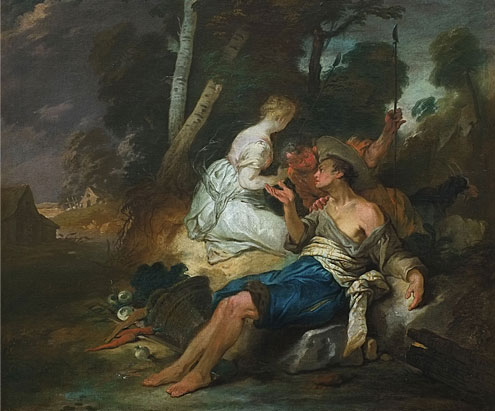Nicolas VLEUGHELS
NICOLAS VLEUGHELS
(1668 Paris - 1737 Rome)
“Scène pastorale - Granida et Daifilo”
c. 1718
after the play by P.C. Hooft
oil on canvas
60 x 67 cm.- 23 ½ x 26 ½ in.
Preis auf Anfrage
Diese E-Mail-Adresse ist vor Spambots geschützt! Zur Anzeige muss JavaScript eingeschaltet sein!
NICOLAS VLEUGHELS trained with his father Philippe Vleughels (ca. 1620-1694), a Flemish painter who had moved to Paris in 1642; he was also a pupil of Pierre Mignard I. In 1694 he came second in the Prix de Rome competition with “Lot and his Daughters Leaving Sodom”; despite repeated attempts, he failed to win the first prize.
In 1704 Vleughels travelled to Italy at his own expense. From his base in Rome he made trips to Venice (1707-9) and Modena (1712-14) and was much influenced by the work of the Venetian colourists, particularly Veronese, whose works he copied (drawings Paris, Louvre, Cab. Dessins).
In 1716, back in Paris, he was approved (agrée) by the Académie Royale and in the same year was received (reçu) on presentation of “Apelles Painting Campaspe” (Paris, Louvre) as ‘morceau de réception’. The influence of Veronese can be seen in the preparatory studies in oil and pastel for his paintings of this period, such as the Studies of a Woman’s Legs for the figure of Campaspe.
He became a close friend of Watteau (they lived 1718-19 under the same Parisian address) and was, like him, greatly influenced by Flemish painting, notably that of Rubens. Their close relationship is confirmed by the survival of several drawings by Watteau of Vleughels, who depicted him in his “Fêtes Vénitiennes” (National Gallery of Scotland, Edinburgh) and “Les Charmes de la Vie” (Wallace Collection, London).
1725 Vleughels was appointed director of the Académie de France in Rome. 1732 he reveals in a letter to his mentor the Duc d’Antin his most promising pupils: Natoire, Boucher, Adam and Bouchardon.
Granida and Daifilo were lovers from the Dutch pastoral play Granida (1605) by Pieter Cornelisz Hooft. Granida, the daughter of an eastern king, betrothed to Prince Tisiphernes, lost her way while out hunting. She came upon a shepherd Daifilo and his mistress Dorilea who had just quarrelled.
Daifilo fetched water for the princess to drink and fell in love with her. He followed her to court and, after several turns in the story, they fled to the woods together to live a pastoral life. Daifilo was taken prisoner by one of Granida's several suitors. They were finally reunited after the intervention of Tisiphernes who yielded his claim to her. The play set a fashion for pastoral idyll in the Netherlands and long remained popular.
Other representations of this subject were executed by Gerard van Honthorst (1625 - Centraalmuseum, Utrecht) and Jacob Adriaensz. Backer (c.1635 - Hermitage, Saint Petersburg).
Bibliography:
S.J. Gudlaugsson, Representations of Granida in Dutch Seventeenth-Century Painting: II, The Burlington Magazine, Vol. 90, No. 549 (Dec., 1948), pp. 348-351
Bernard Hercenberg, Nicolas Vleughels, Peintre et Directeur de l'académie de France à Rome 1668-1737, Paris 1975

